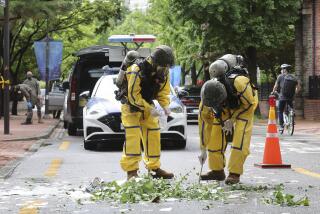S. Korea Shows Contested Isles to Press (No Japanese Allowed)
ABOARD THE SAMBONGHO — Even before the boat left the dock, the South Korean flag was unfurled and passengers lined up to pose for photographs against the backdrop of the banner fluttering in the wind.
The coast guard boat Sambongho was on its way to Dokdo, a cluster of sparsely inhabited islets 134 miles off the east coast of the Korean peninsula that have inspired much nationalistic flag-planting in their day.
Dokdo is the source of perennial squabbling between South Korea and Japan, but never more so than in the last two months as Japanese nationalists started pressing their claim to islets they call Takeshima.
To solidify its hold on the rocks it has controlled since the 1950s, South Korea arranged a tour for foreign correspondents: Americans, Britons, Chinese, a Russian and a Singaporean, that is. No Japanese were included, although they make up the largest contingent of foreign correspondents in Seoul.
The Japanese claim has turned Dokdo into something of a national obsession in South Korea. People have taken to wearing Dokdo T-shirts, sneakers and even underwear. The islets’ image dangles from key chains and mobile telephones. Both South and North Korea have issued Dokdo stamps.
The phrase Dokdo-nun uri ttang -- Dokdo is our land -- has become a national mantra.
“Dokdo is a breakthrough issue for us. We are showing our dynamic energy just like we did with the 2002 World Cup,” Park Hyeong Ju, a 28-year-old government employee who was carrying a South Korean flag, explained on the boat.
Park was referring to the soccer tournament held in Japan and South Korea that brought millions of Koreans into the streets.
No issue since then has so united South Koreans, not even North Korea’s declaration that it has a nuclear bomb. Whereas tens of thousands of Chinese demonstrated recently against Japan’s approval of history textbooks that glossed over its brutal treatment of its Asian neighbors before and during World War II, South Koreans saved their ire for the Dokdo issue.
Koreans make much of the natural beauty of Dokdo, describing it in ever more hyperbolic terms.
True to its billing, Dokdo is striking, with twin peaks rising steeply from the sea like upside-down ice cream cones. The mist gives it an ethereal quality.
“Ah, yes, it is a beautiful island. They say that heavenly gods have visited there,” exclaimed Kim Byung Ryul, a historian from the Korean National Defense University.
But natural beauty aside, Dokdo isn’t much of a prize. Most likely, Koreans wouldn’t even know where it was if not for Japan’s claim, admitted Lee Seong Jin, who runs a museum of Dokdo memorabilia on the nearby South Korean island of Ulleungdo.
“We wouldn’t have to think twice about it if Japan weren’t making a fuss,” Lee said.
The small rocks are barely habitable, with little fresh water and terrain so steep that peaks had to be blasted away to create flat surfaces for building.
For all but about 40 days a year, rough surf and wind make the islands inaccessible. Last month, the South Korean government started permitting tourists to visit, but heavy waves often keep the boats away.
Similarly, journalists were not able to disembark, instead gazing upon Dokdo’s charms from the safety of the 5,000-ton coast guard ship. As a consolation, old-timers from Ulleungdo were sent to hold forth on the essential Koreanness of the islets. They regaled the press corps with their stories in a conference room where heavy chairs slid about as waves tossed the ship.
The islets are uninhabited except for 37 police officers, who rotate every two months, and three people who work in a lighthouse. There are also two dogs, a traditional Korean breed called the Sapsal.
The dispute dates back to the aftermath of World War II, when the United States and its allies put an end to Japan’s 35-year occupation of the Korean peninsula. Postwar treaties left the question up in the air.
Eager to cement their claim, the South Koreans started establishing a presence on Dokdo during the 1950s.
As the coast guard ship lurched over the swelling surf, 77-year-old Chung Won Do recalled that in 1953, he and his friends were sent with only a small fishing boat to prevent Japan from staking a claim. The Koreans carved a decoy cannon out of wood to make the Japanese think they were stronger than they were.
“We are not as strong as we used to be, but we are still willing to defend Dokdo,” said Chung, referring to himself and a friend, 82-year-old Lee Pil Yong.
The most recent eruption of hostilities occurred last month, when lawmakers in Japan’s Shimane prefecture, the closest to Dokdo, passed a resolution designating Feb. 22 as Takeshima Day to celebrate Japan’s claim.
In advance of the media tour, the South Korean government held a briefing and slide show about Dokdo’s history. Enlarged on-screen were maps dating to the 18th century showing Dokdo in Korean territory and 19th century Japanese-language documents that seemed to acknowledge Korean sovereignty.
Of course, the Japanese have their own arsenal of maps and documents that they say prove their ownership.
Nevertheless, the islets today remain firmly in South Korean hands, and there seems to be little that Japan can do about it. South Korean police and coast guard officers say they don’t fear a Japanese attack on the islets. Instead, the biggest hazards are the 20-foot swells and an anticipated influx of South Korean tourists traipsing over the delicate volcanic rock.
“We’re afraid too many tourists will destroy this place,” said Lee, the museum director.
More to Read
Sign up for Essential California
The most important California stories and recommendations in your inbox every morning.
You may occasionally receive promotional content from the Los Angeles Times.










